The 10 Best Board Games of 2022
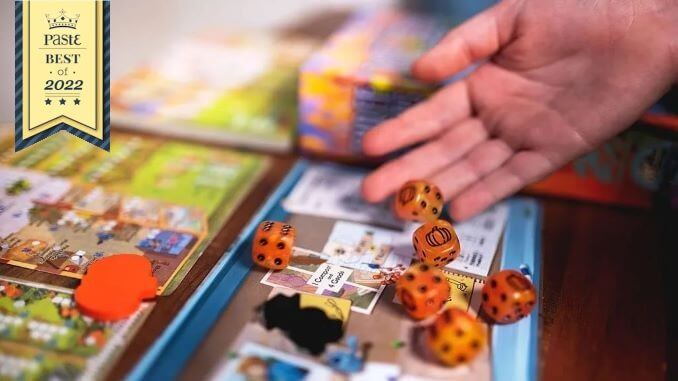
For board games 2022 was pretty close to pre-pandemic levels, from the number of new releases to conventions to sheer quality of offerings. There are always more good new games each year than I can play, assuming I even have access to them in the first place. This is the best of what I was able to try. There were other games I liked that just didn’t make the cut here, and there are games I know about but haven’t actually played, so I can’t include them. I don’t log my plays (some players do), so I don’t know exactly how many new games I played, but it’s well north of 50, and I would say I played 20 or more that were good enough to recommend. Here’s my top 10 for the year.
10. Kites
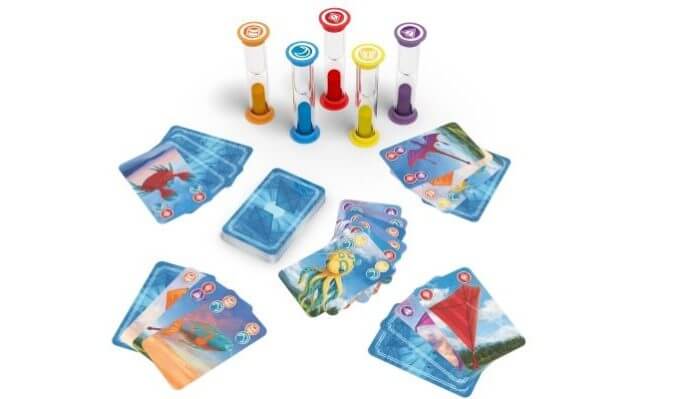
I don’t play a lot of real-time or dexterity-based games, as they’re just not my bag, but Kites is an exception for me. There are six sand timers in different colors, each with a different duration to empty, and players must play cards from their hands to flip one or two timers at a time to prevent any of them from running out. Cards show either one timer’s color or two of them, and if you play any card you must flip the timers shown, even if that puts one close to emptying. You play cards until you’ve completed the entire deck and all your hand cards, in which case you win as a team, or until a timer runs out, at which point you count the cards left in the deck/your hands and let that be your score. It only takes about 10-15 minutes and plays anywhere from two to six players. The timers are set tightly enough that you’re always in jeopardy of losing, which raises the tension and, for me at least, the fun.
9. Splendor Duel
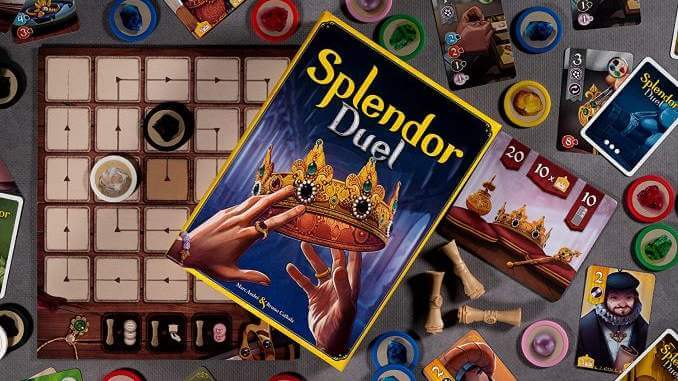
One knock on the original Splendor has been that it’s not that great as a two-player game, with no real player interaction and limited churn of the cards on the table. Splendor Duel addresses both of those points, but without overhauling the core game, adding just a few small bits of interaction while making the token- and card-selection aspects of the game more competitive. The basic game is still here: on your turn, you either collect up to three tokens on a turn, or you spend tokens to buy a card from the display. In Splendor Duel, you take tokens from a shared board with a spiral track, and take up to three tokens in any line. You don’t refill the track with spent tokens until someone spends a parchment token to do so, which becomes a part of your strategy. Cards you buy may also have bonus powers once completed, such as letting you immediately take a second turn or steal a token from your opponent. I prefer the original Splendor, even two-player, but this is a strong two-player game on its own merits.
8. Lacrimosa
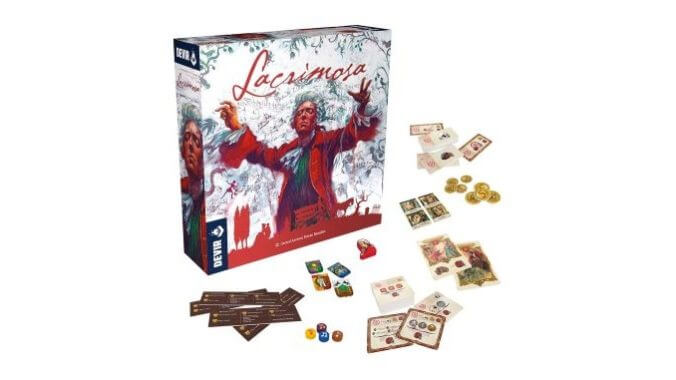
A stunning game on the table, Lacrimosa has an unusual theme—players are patrons of Wolfgang Amadeus Mozart and must play five rounds representing epochs of his life, commissioning music from him and traveling with him for money and other resources—and a great little deckbuilding mechanic at its heart. You start with a nine-card deck that determines the four actions you’ll take in each round, but when you buy a new card to upgrade your deck, you must discard one of the two cards you played in that same turn, so your deck stays at nine cards. You’ll try to boost your income and hire musicians to help complete the Requiem that Mozart left unfinished at his death. The rulebook isn’t great and a few details weren’t that clear, but once we got rolling with Lacrimosa, our turns were quick and the game was surprisingly fun for its difficulty. And it looks great on the shelf as well.
7. Get on Board: New York & London

A redo of a 2018 game released in Japan called Let’s Make a Bus Route!, Get on Board has two to five players placing route markers on a shared map of one of the game’s two cities, with New York for two to three players and London for four to five, trying to hit landmarks and deliver passengers to their preferred building types, with public and private objectives for further scoring. It’s a flip-and-write, where on each turn, someone flips the next ticket in the deck, but that means a different shape for each player to place. After extending your route, you mark off any passengers and buildings your bus line hits on that turn, and gain bonuses for completing certain rows or other milestones. It’s highly replayable and taut enough that you’ll probably find completing something important comes down to the 12th and final turn. It’s from the same designer as Coffee Roaster, the best purely solitaire board game I’ve ever played.
6. Terra Nova

I say this with the disclaimer that I have always found Terra Mystica to be too long and kind of boring, despite its dedicated following and status among hardcore board gamers, but Terra Nova is just better in every way. It maintains the core theme of the original, with players taking on different races, each of which can only live on one specific type of terrain tile, and then terraforming other tiles to allow them to expand, building houses and then converting them to larger buildings for more points and area control. Terra Nova cuts the game time by about half, simplifies some of the rules by stripping things the original didn’t need, and moves along much more quickly between your turns. It has the feel of a classic Euro without the long playing time or joyless vibe of Terra Mystica.
5. Verdant

Flatout Games doesn’t miss, as the publisher/collective have already had hits with Calico, Cascadia (my #3 game of last year), TEN, and Point Salad. Verdant borrows some mechanics from Cascadia while bringing the game indoors—you’re trying to create a tableau of cards representing your house, with alternating room cards and houseplant cards. You want to put cards of the same color adjacent to each other, and make sure you have the correct amount of sun hitting your plants, and try to gather decoration tokens for your rooms. It plays quickly, as each player starts with one card and gets 14 turns to build the 3×5 tableau, although it’s a bit of a table-hog. And the art, as always, is fantastic; it’s by Beth Sobel, who did art for three games on this list (Kites, Verdant, Three Sisters), as well as the art for Calico, Cascadia, and a modest little game called Wingspan.
4. My Lil Everdell
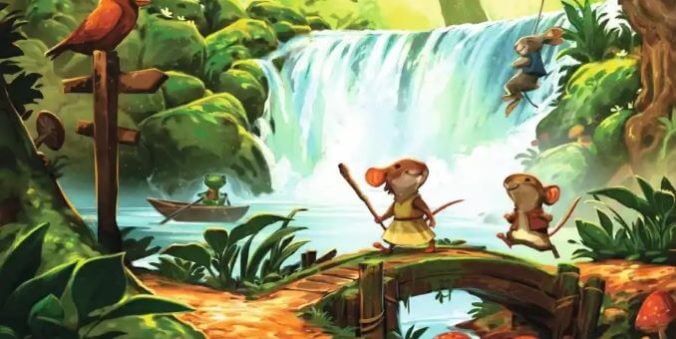
This was a great year for new kids’ games, with Ouch! for the youngest set (ages 4+); Quacks & Co., a kids’ version of The Quacks of Quedlinburg, for the ages 6+ set; and My Lil Everdell, a kids’ version of Everdell for kids ages 6+ as long as they can read. My Lil Everdell has the same familiar art and basic setup—players place their workers on a common board to collect resources, and use those to buy cards they’ll place in their own tableaus. This version simplifies the original in several ways, getting rid of one resource, reducing the competition for resources with much friendlier spaces on the board, and eliminating the tech tree, where owning one card might make another card free. On your turn, you can either get resources or buy a card. There are simple bonuses for getting one card of each of the five colors, or three cards of a single color, or five Construction cards, or five Critter cards. At game end, you add up the point values of your twelve cards, any bonuses you earned, and bonuses on purple cards that give you extra points for other cards you have that meet certain criteria. The text on the cards is simple enough for early readers, and the scoring is straightforward. It simplifies Everdell without dumbing it down, enough that even as an adult who loves the original game I found this extremely satisfying to play.
3. Three Sisters
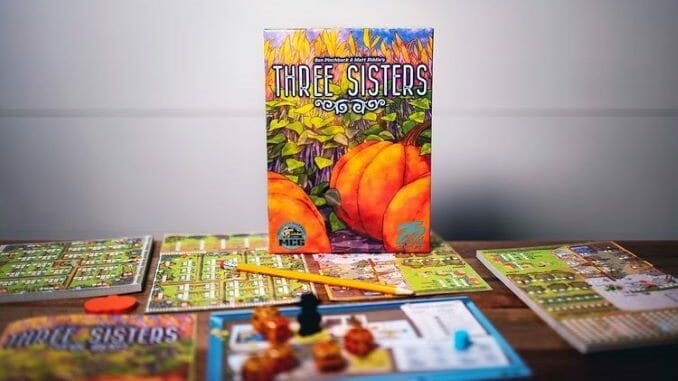
This has been a huge year for roll-and-write games, as many publishers and designers seek to capitalize on the genre’s popularity with brand-new titles or extensions of previous ones (such as Twilight Inscription, Joan of Arc, and the forthcoming Terraforming Mars: The Dice Game). Three Sisters is an original game from the designers of another very popular roll-and-write, Fleet: The Dice Game, this time taking its theme from the Native American farming system that uses corn, squash, and beans together for their symbiotic relationships. Bean plants fix nitrogen in the soil for the other two plants, and use the corn stalks as natural trellises, while squash provides ground cover to block competition in the form of weeds. Players roll dice to mark off spaces in their garden to represent all three of those plants, and can also use dice to gain farming tools or advance on the fruit tracks, working with two separate sheets of paper to try to chain bigger and longer bonuses as the game progresses. A good roll-and-write should leave you with a big puzzle as you try to find the best paths to free stuff (that is, marking off more boxes for each roll), and Three Sisters is one of the best at it.
2. Cat in the Box
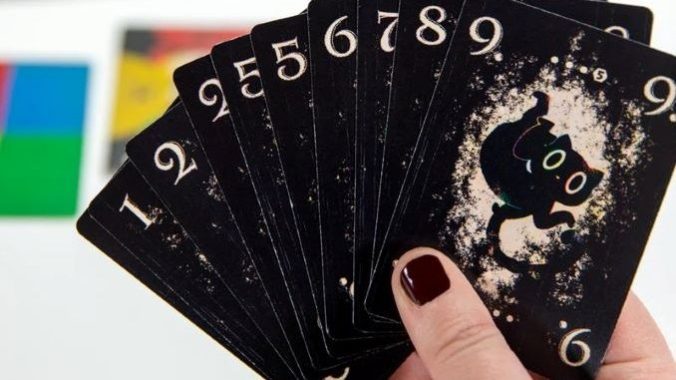
What if you turned the Schrödinger’s Cat thought experiment into a fun and clever board game? Cat in the Box does just that, taking that hoary and often misunderstood physics topic—I’m sorry, the cat is not simultaneously alive and dead, that’s not a thing—and grafting on to the similarly overdone trick-taking genre in a way that truly incorporates the theme into game play. The cards in Cat in the Box’s deck all have numerical values but no suits, because no one knows a card’s suit until it is observed—that is, played—to the table, at which point the player declares its suit, saying, for example, “this is a green four.” That also means there can’t be another green four in the deck in that round, so the player marks off that place on the shared board, and your options become fewer as the round progresses. You can gain points from winning tricks, from hitting your prediction for how many tricks you’ll win in that round, and from placing tokens on that board next to each other. If you can’t make a legal play, however, you cause a paradox and the world collapses into a singularity, by which I mean the round ends and you don’t score. It’s fun, fast, and easy to teach. Also, you don’t have to kill any cats to play it.
1. Ark Nova
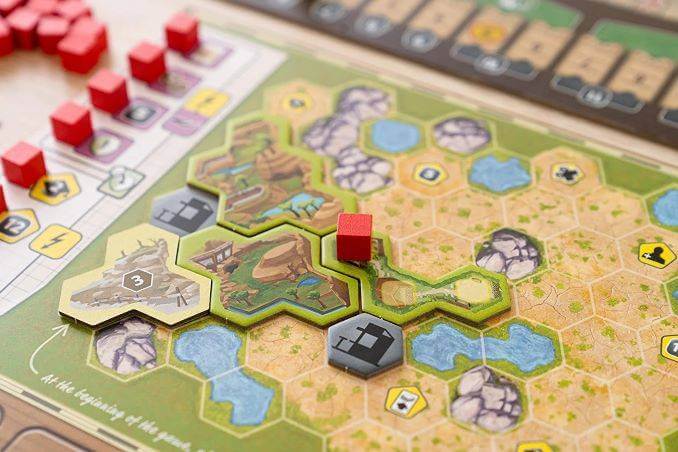
The best new game of 2022, Ark Nova does a lot of things we’ve seen before, but does them well, and manages to make a two-hour game feel faster and less ponderous than many games of that time commitment. The game borrows familiar mechanics from Terraforming Mars, Bärenpark, Great Western Trail, Rajas of the Ganges, and other popular games while still managing to give you the sense that you’re playing something new. Players try to build out their personal zoos, placing enclosure tiles in various shapes and gaining bonuses based on what they cover, and then acquiring animals to fill those spaces for further points. There’s an action-selection mechanism that makes an action less powerful the more you use it, and which also makes single-minded strategies more difficult to pull off. The game doesn’t offer much interaction, which is the main criticism of the fantastic game Wingspan, but other than that, Ark Nova is about as good as a heavy tabletop game can get.
Honorable mentions: Quacks & Co.; It’s a Wonderful Kingdom; Long Shot: The Dice Game; Next Station: London; Riverside; The Spill.
Keith Law is the author of The Inside Game and Smart Baseball and a senior baseball writer for The Athletic. You can find his personal blog the dish, covering games, literature, and more, at meadowparty.com/blog.